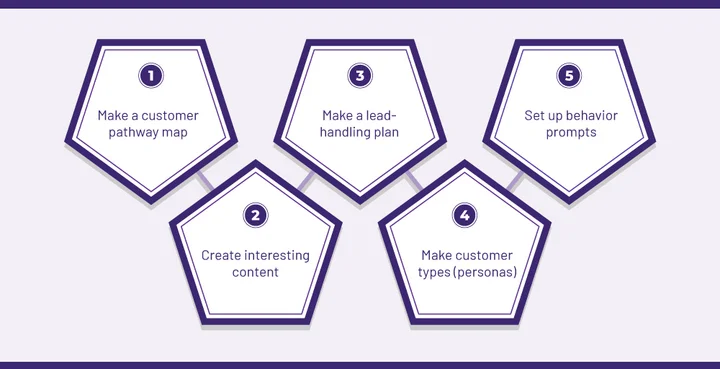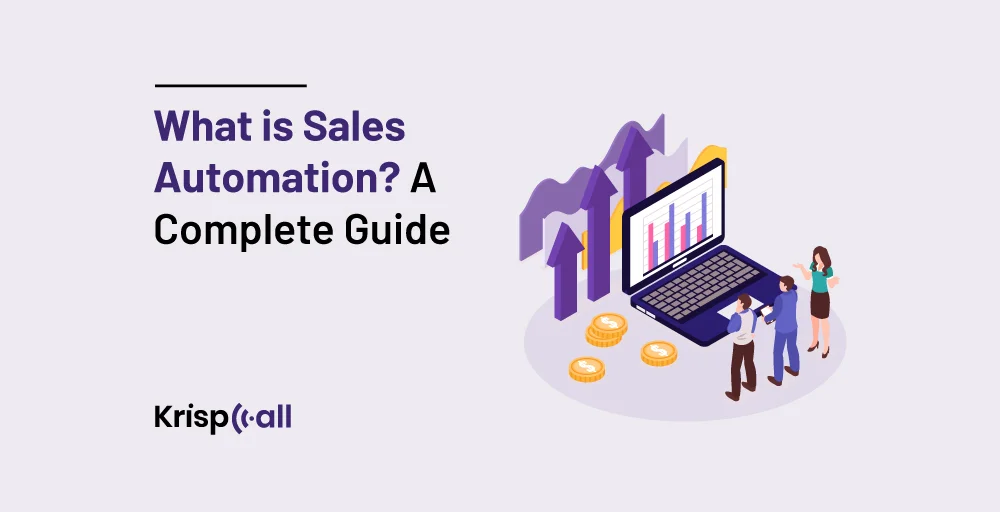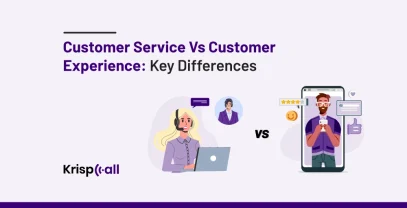More time for sales means more money in your pocket. But how can you give your sales team more time? 🤔 Through Sales Automation.
These days, with so much competition, if you’re not using sales automation, you’re missing out on key factors in your business’s growth. 📈
Sales automation is a game-changer for any business. It streamlines processes between marketing and sales so reps can focus on other important tasks. Those who aren’t automating certain sales workflows are missing out on growth opportunities.
In this article, we will explore what sales automation is, its benefits, how it works, its key features, and best practices.
Let’s begin. 👇
🔑 KEY HIGHLIGHTS
- Sales automation helps automate marketing tasks and interactions between sales and marketing teams.
- Automating repetitive tasks allows sales teams to focus on client conversion and drive more sales.
- Sales automation uses technology to handle routine sales tasks such as sending emails, making phone calls, and organizing customer data.
- Key features of automation tools include guidance, lead management, communication, data entry, record creation, and research capabilities.
- Best practices for implementation include mapping the customer journey, creating engaging content, handling leads well, and customizing based on customer personas.
What Is Sales Automation?

Sales automation refers to software capabilities that use AI-powered chatbots/assistants to automatize routine tasks important for developing straightforward and lucrative customer experiences. It is frequently incorporated as a component of CRM platforms, lead-generation solutions, and email marketing tools.
But sales automation doesn’t mean robots will do the whole sales process without humans. People are still very important for selling. Salespeople have personal conversations to build relationships with customers.
Any company’s automation plan aims to automate easy work so salespeople can focus on essential things humans do better, like talking to customers. Favorable connections come from real people, not computers.
You don’t need to automate anything that makes you or your sales staff uncomfortable. Any automation that customers or potential buyers don’t like should be avoided. Making customers unhappy is the opposite of what companies want automation to achieve.
For example, when a potential customer fills out a contact form on a company’s website, the company can automatically add them as a new contact in the customer relationship management (CRM) system. At the same time, sales automation can assign salespeople tasks to follow up with that person. It can also enroll the new contact in a marketing plan, where they get emails with offers and information.
This happens without salespeople having to manually type info into the CRM or remember to contact the person. The technology handles data entry and reminders so salespeople immediately notice interested potential buyers and can reach out to discuss products or services.
Benefits of Sales Automation
Your sales team members and overall business can significantly benefit from sales automation. It can benefit you in the following ways:
- Boost Efficiency And Productivity: Sales automation helps salespeople accomplish their tasks by taking over boring, repetitive paperwork tasks. It also eliminates slow-down activities like manual list calling. Setting up automated messages and calls means sales teams aren’t held back from doing important customer work just because of repetitive chores.
- Increase Sales: Sales automation helps sell more products and services. It lets sales teams concentrate on talking to customers instead of wasting time on busy work, making it easier for reps to close deals. This results in higher profits because companies can sell more with automation, which allows the sales process to run smoothly.
- Improve Lead Generation: Sales automation helps companies find people who are more likely to buy. Instead of spending time with every single person who encounters the business, reps can concentrate on “warm leads”—customers showing real interest. This improves the number of sales that reps generate because they get the most from each interaction by focusing on customers primed to complete a purchase.
- Retain More Customers: Companies need to keep customers happy even after they buy something. Building good relationships with buyers over time helps them stay loyal customers. If brands put effort into nurturing customers long-term using automation, those customers will stick around longer, which means more money will be earned over time.
- Report Creation: Sales reports are important because they give companies the details needed to make smart choices. However, creating the reports takes a long time if salespeople have to type everything out in spreadsheets. Sales automation provides accurate data in easy-to-read formats so executives can make informed calls to improve business results.
- Better Onboarding For Sales Reps: When sales teams use messy, unorganized methods, it’s hard for new people to get up to speed quickly. But automation helps make training easier because everyone follows the same clear steps and uses the same tools. With automation in place, newcomers don’t have to waste time figuring things out on their own. They can learn the sales process smoothly since it’s all laid out the same way digitally.
- Improve The Customer Experience: Customers today want quick and easy service from companies. Sales automation helps meet those expectations. Speedy responses also indicate the business is organized and keeps things moving efficiently. Customers appreciate companies that provide a smooth experience through automated tools. It creates happy buyers, which is important for gaining loyal customers and repeat sales.
How does Sales Process Automation work?
Sales automation uses different tools to help improve how companies sell their products. Here are some key things automation can do:
- Screen leads: It helps identify good potential customers faster from others who aren’t the right fit yet. This pre-qualifies who reps should actually talk to.
- Handle messages on its own: With AI outreach tools you can automatically send follow-up emails, offer notifications, and more without salespeople having to do it manually each time, saving the team time.
- Create detailed reports: It quickly gathers all the important numbers and metrics into clear reports so managers can see how the business is doing and make adjustments.
- Manage the sales process: Give everyone a full picture of where prospects are when deciding to buy. Then, reps can interact strategically to convert interested people into paying customers.
- Forecasting revenue and estimates: It lets you predict business trends so businesses are ready for whatever comes.
- Scheduling meetings and demos efficiently: Quickly set up sales calls and product showings based on rep availability so clients get answers fast.
- Making custom quotes in a snap: Automation ensures accurate, competitive pricing proposals to help win contracts.
- Tracking employee work: It tracks employee work by keeping an eye on both clients and how reps are performing.
- Managing orders smoothly: The software alerts you about delays or issues so customers stay happy with order updates and problem-solving.
Once sales teams learn automation tools, they can improve their methods and gain advantages such as saving more time, increasing sales, and satisfying buyers. Automation enhances the whole process from start to finish of any sale.
👋 You May Also Like: 10 Best Sales Tracking Software Tools
Key Features of Sales Automation Tools
Automated tools work like personal assistants for sales teams. They take care of repetitive jobs accurately and on schedule without needing to be told, such as:
1. Guidance

Automation can smoothly guide the selling process. It reminds reps of upcoming steps, meetings, or deadlines through automated reminders and alerts.
This helps sales adhere to important timelines, just like a real assistant would. The software monitors responsibilities and lets employees know when certain things are coming up. That means fewer dropped balls and missed chances to close deals. Automation acts as a planner that ensures everything stays on track from start to finish.
2. Lead Management
Automation can also help manage leads better. It looks at how potential customers act online, then sorts, ranks, and schedules whose info gets sent to which rep. Doing all that sorting by hand would waste tons of a salesperson’s time.
But software breezes through huge piles of contact data in just minutes. It lists top prospects sorted into the perfect order for the most effective sales calls. This research arms reps with the most promising customers already prepped and ready to talk to.
3. Communication
Automation helps with communication in many ways like email, chat options, and scheduling meetings. Sales teams are always swamped with work, but buyers now want instant answers. Communicating through automation sets up systems to automatically reply to customers.
The automation handles initial questions and sign-ups. It frees up employee time to focus on important deals while still providing the quick response experience that is expected nowadays. Communication automation gives people assistance whenever needed while keeping sales teams productive with fewer interruptions.
4. Data Entry
One of the most boring parts of a salesperson’s job is typing in all customer information by hand. Automated data entry saves reps from spending hours on repetitive paperwork.
The automation can fill in contact specifics and pricing choices automatically. This means reps don’t waste time manually inputting what a program can do in seconds.
5. Record Creation
Automation also automatically sets up new contact pages for people interacting with ads or other company info. It saves their email addresses and other details directly into the customer relationship management (CRM) system for anyone to see.
Before, data entry was done manually, which took more time. Now, programs build profiles on their own as potential buyers make first contact. Having records built instantly means all departments, like sales and marketing, can easily see who’s interested and work with them right away.
6. Research

Online contact research can be automated. Every day, there are an endless number of public details on companies posted all over the web and on social media. Research bots scan through it all, hunting for leads that could be valuable buyers.
The software filters through huge piles of online data that sales reps never have time for. It spots potential customers and organizes their information for reps to review. Before, many potential businesses slipped through the cracks since manually browsing the Internet was impossible. Automated hunting finds opportunities that sales reps would otherwise miss out on.
7. Activity logging
Automation lets sales teams track what everyone is doing with potential customers. It follows emails, scheduled meetings, and phone calls so managers and reps can see the progress of any sales opportunity.
Knowing which steps have occurred and which are still ahead keeps the process uniform each time. Logging happens automatically, so reps don’t waste time entering it manually themselves.
Best Practices for Implementing Sales Automation

While sales automation means using new software, it also takes planning your strategy and connecting the technology to your business goals.
Here are some tips for teams starting to use sales automation effectively:
1. Make a customer pathway map
Making a customer journey map shows how customers interact with your company from first contact through after the purchase. Understanding this pathway helps salespeople see where customers have problems or when they would want to hear from you.
First, think about your goals, such as getting more leads, keeping current customers, or improving customer experience (CX). Clear aims can guide the automation plan and customer pathway. Planning helps you link technology directly to achieving your business objectives.
2. Create interesting content
Content that grabs people’s attention is key to successful sales. It makes customers want to keep listening to your brand while taking the next step.
Automated messages sent to the customers need to be engaging, too. They should be thought-provoking and appealing messages that address what customers care about. Automation works best when awesome content is behind it.
3. Make a lead-handling plan
Good lead follow-up helps turn possible buyers into real ones. A clear plan guarantees sales reps give prospects the right attention so no opportunities are missed.
Automation can smooth out these steps. With a strong scoring process to rate how hot a lead is, marketers can use automated messages and bots to provide custom info for where leads are in the process.
4. Make customer types (personas)
Personas describe who your main customer groups are. They list what buyers want and don’t like and what motivates their purchases.
This understanding is important for customizing messages for each type of customer. Sales automation works better when the automated communications fit the needs of special groups.
5. Set up behavior prompts
These automated or canned responses happen based on what customers do, like visiting website pages or adding items to carts. It allows customized messages tailored to what interests a person right now.
Timely automated messages that fit what someone is doing make them more useful. Whether bots send an email after someone looks around online or recommend new products based on history, this approach boosts how much customers interact and keeps them interested in buying.
Conclusion
So, is sales automation worth it? 🤔 The answer is a straight yes because sales automation can speed up what you have to do a lot. This lets you improve your sales rate and generate more money for your business.
From finding new leads and managing customer connections to customized contact and detailed statistics, sales automation boosts effectiveness. It lets sales reps focus on finalizing contracts and building connections. It also reduces boring, repetitive paperwork and long-term jobs.
Ultimately, using these tools is worth it because they significantly increase sales and work efficiency.
FAQs
What are the common challenges while implementing sales automation?
Some of the common challenges while implementing sales automation are:
- Finding the right framework and tool.
- Effective communication & collaboration in the team.
- Identifying the test automation strategy.
- Setting realistic expectations of automation.
- High initial investment.
- Inadequate testing infrastructure.
- Problems with data reliance.
- Finding the right skills.
When it comes to sales automation, what are the responsibilities of managers?
When it comes to sales automation, the responsibilities of managers is that they need to ensure that all sales representatives understand how to use the new automated systems and enter customer data correctly. Their main duty is to help reps effectively utilize the tools to ultimately increase sales.
How does automating sales improve sales productivity?
Automating sales improves sales productivity by getting rid of tasks that take a long time and have to be done by hand with automation. As a result, reps can spend their working hours differently. They don’t need to focus as much on paperwork and organizing stuff. They can pay more attention to actually talking to customers and closing deals.
What are the differences between Sales Automation and CRM?
The difference between sales automation and CRM is that CRM software helps keep current customers happy and loyal to the company. In contrast, sales automation is more related to getting new customers. While they both deal with customers, CRM focuses on retaining the customers that already exist, and sales automation concentrates on finding and signing up prospective clients that a company doesn’t have yet.
What are the responsibilities of sales reps when it comes to sales automation?
Sales reps’ responsibilities regarding sales automation include learning and using new automation tools correctly. They must also enter important customer information, such as leads and contacts, into the system. Moreover, they must review what the automation suggests and approve or change actions.





